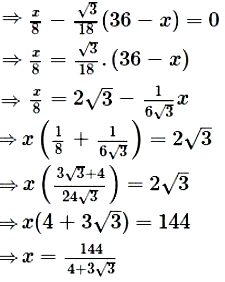Let the length of one piece be x, then the length of the other piece will be 36 - x.
Let from first piece we make the square, then
x = 4y
⇒ \(y=\frac{x}{4},\) ...(i)
Where y is the side of the square
From the second piece of length (36 - x) we make an equilateral triangle, then side of the equilateral triangle = \((\frac{36-x}{3})\)

Now combined area of the two =
A = \((\frac{x}{4})^2\,+\) \(\frac{\sqrt{3}}{4}\) \((\frac{36-x}{3})^2\)
Differentiating with respect to x, we have,

For maximum/minimum, we have
\(\frac{dA}{dx}=0\)

Thus, length of one piece is \(x=\frac{144}{4+3\sqrt 3}\) and the length of other piece is :
\(36-\frac{144}{4+3\sqrt 3}\)
\(= \frac{144+108\sqrt3-144}{4+3\sqrt{3}}\)
\(= \frac{108\sqrt3}{4+3\sqrt{3}}\) cm.